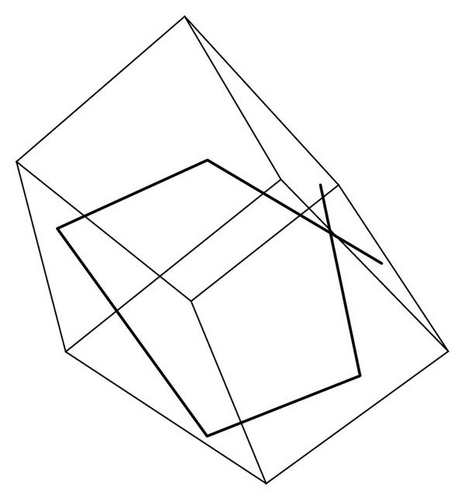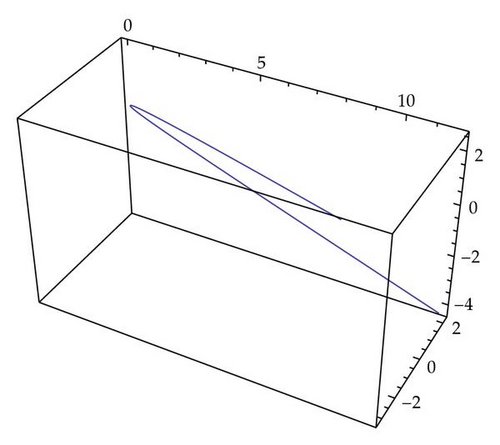An Underactuated Drift-Free Left Invariant Control System on a Specific Lie Group
Abstract
The paper presents a geometrical overview on an optimal control problem on a special Lie group. The Hamilton-Poisson realization of the dynamics offers us the possibility to study the system from mechanical geometry point of view.
1. Introduction
Recent work in nonlinear control has drawn attention to drift-free systems with fewer degrees than state variables. These arise naturally in problems of motion planning for wheeled robots subject to nonholonomic controls [1], models of kinematic drift effects in space subjects to appendage vibrations or articulations [1], the molecular dynamics [2], the autonomous underwater vehicle dynamics [3], the car′s dynamics [4], and spacecraft dynamics [5]. The purpose of our paper is to study a class of left-invariant, drift-free optimal control problems on a specific Lie group G. The class of all control-affine left-invariant, drift-free optimal control problems on G can be reduced to a class of two typical controllable left-invariant control systems on G. The left-invariant, drift-free optimal control problems involve finding a trajectory-control pair on G, which minimizes a cost function and satisfies the given dynamical constrains and boundary conditions in a fixed time. The problem is lifted to the cotangent bundle T*G using the optimal Hamiltonian on 𝒢*, where the maximum principle yields the optimal control. The energy-Casimir method is used to give sufficient conditions for nonlinear stability of the equilibrium states. Around this equilibrium states, we are able to find the periodical orbits using Moser′s theorem. In the last paragraph, we have studied the numerical integration via three methods: Lie-Trotter algorithm, Kahan′s algorithms, and Runge-Kutta 4th method. Numerical simulations and a comparison between these three methods are presented too.
2. The Geometrical Picture of the Problem
Proposition 2.1. The Lie algebra 𝒢 of G is generated by
Proposition 2.2. The minus-Lie-Poisson structure on 𝒢*≃(R4) *≃R4 is generated by the matrix
An easy computation leads one to the following.
Proposition 2.3. The following two systems are drift-free-left invariant controllable systems on G, namely:
Proof. Since the span of the set of Lie brackets generated by A1, A2, and A3 coincides with 𝒢 the proposition is a consequence of a result due to Jurdjevic and Sussmann [6].
3. An Optimal Control Problem for the System (2.5)
Then we have the following.
Proposition 3.1. The controls that minimize J and steer the system (2.5) from X = X0 at t = 0 to X = Xf at t = tf are given by
Proof. Let us consider the optimal Hamiltonian given by
Remark 3.2. It is easy to see from (3.3) that x4 = constant, and so the dynamics (3.3) can be put in the equivalent form
The goal of our paper is to study some geometrical and dynamical properties for the system (3.8).
Proposition 3.3. The dynamics (3.8) has the following Hamilton-Poisson realization:
Proof. Indeed, it is not hard to see that the dynamics (3.8) can be put in the equivalent form

Proposition 3.5. The dynamics (3.8) has an infinite number of Hamilton-Poisson realizations.
Proof. An easy computation shows us that the triples
Remark 3.6. The above proposition tells us in fact that (3.8) is unchanged, so the trajectories of motion in ℝ3 remain the same when H and C are replaced by linear combinations of H and C with coefficients which form a real matrix with det one.
4. Stability and Periodical Orbits
Proposition 4.1. The equilibrium states , are spectrally stable if .
Proposition 4.2. The equilibrium states and , are spectrally stable for any M ∈ R.
We can now pass to discuss the nonlinear stability of the equilibrium states , and , M ∈ ℝ.
Proposition 4.3. The equilibrium states , are nonlinearly stable if .
Proof. We will make the proof using energy-Casimir method (see [7]). Let
Now, the first variation of Hφ is given by
Similar arguments lead us to the following result.
Proposition 4.4. The equilibrium states and are nonlinearly stable for any M ∈ ℝ*.
In order to find the periodical orbits around the equilibrium states , we make use of the property that the dynamics described by a Hamilton-Poisson system takes place on the symplectic leaves of the Poisson configuration manifold, to prove the existence of periodic orbits by looking for periodic orbits of the symplectic Hamiltonian completely integrable system obtained by the restriction of the Lorenz system to the regular coadjoint orbits of G*. This procedure will be implemented around nonlinearly stable equilibrium states. The procedure is the following: we consider the system restricted to a regular coadjoint orbit of G* that contains a nonlinearly stable equilibrium, and then we will get the existence of periodic solutions for the restricted system. These periodic solutions are periodic solutions also for the unrestricted system.
Proposition 4.5. Near , , the reduced dynamics has, for each sufficiently small value of the reduced energy, at least 1 periodic solution whose period is close to
Proof. Indeed, we have successively the following:
-
(i) the restriction of our dynamics (3.8) to the coadjoint orbit
()gives rise to a classical Hamiltonian system, -
(ii) the matrix of the linear part of the reduced dynamics has purely imaginary roots. More exactly
() -
(iii) consider the following:
()where() -
(iv) the reduced Hamiltonian has a local minimum at the equilibrium state (see the proof of Proposition 4.3).
Then our assertion follows via the Moser-Weinstein theorem with zero eigenvalue; see [8] for details.
Remark 4.6. The existence of the periodical orbits around the equilibrium points e2 and e3 remains an open problem, the Moser-Weinstein theorem with zero eigenvalue being inconclusive.
5. Lax Formulation and Numerical Integration of the Dynamics (3.8)
Proposition 5.1. The dynamics (3.8) allows a formulation in terms of Lax pairs.
Proof. Let us take the following:
We will discuss now the numerical integration of the dynamics (3.8) via the Kahan integrator, Lie-Trotter integrator [9], and also via Runge-Kutta 4th steps integrator, and we will point out some properties of Kahan and Lie-Trotter integrators.
Using MATHEMATICA 8.0, we can prove the following proposition which shows the incompatibility of the Kahan′s integrator with the Poisson structure of the system (3.8).
Proposition 5.2. Kahan′s integrator (5.3) has the following properties:
-
(i) it is not Poisson preserving;
-
(ii) it does not preserve the Casimir C of the Poisson configuration (ℝ3, Π);
-
(iii) it does not preserve the Hamiltonian H of the system (3.8).
We will discuss now the numerical integration of the dynamics (3.8) via the Lie-Trotter integrator.
Now, a direct computation or using MATHEMATICA leads us to the following.
Proposition 5.3. The Lie-Trotter integrator (5.8) has the following properties:
-
(i) it preserves the Poisson structure Π;
-
(ii) it preserves the Casimir C of the Poisson configuration (ℝ3, Π);
-
(iii) it does not preserve the Hamiltonian H of the system (3.8);
-
(iv) its restriction to the coadjoint orbit (𝒪k, ωk), where
()
Remark 5.4. If we compare these methods, see Figures 2, 3, and 4, with the 4th-step Runge-Kutta method, we can see that Lie-Trotter integrator and Kahan′s integrator give us a weak approximation of our dynamics. However, Kahan′s integrator and the Lie-Trotter integrator have the advantage of being more easily implemented.



6. Conclusion
The paper analyses a drift-free left invariant controllable system on a special Lie group. The Hamilton-Poisson realization of the system allows us to study the system from the mechanical geometry point of view. This means that we can use specific tools as energy-Casimir method for nonlinear stability, the Moser′s theorem to find the periodical orbits, and Poisson integrators to make the numerical integration of the dynamics. In addition, we use non-Poisson integrators (Kahan′s integrator and Runge-Kutta 4th-step integrator) to make a comparison between the obtained results. Numerical simulations via MATHEMATICA 8.0 are presented too. Similar problems have been studied on the Lie groups SO(3), SO(4) (see [10]), on the Heisenberg Lie groups H(3) and H(4), or SE(2, ℝ) × SO(3) (see [11]).
Acknowledgments
This paper was supported by the project “Development and support of multidisciplinary postdoctoral programmes in major technical areas of national strategy for Research-Development-Innovation” 4D-POSTDOC, Contract no. POSDRU/89/1.5/S/52603, and the project was cofunded by the European Social Fund through Sectorial Operational Programme Human Resources Development 2007–2013.




